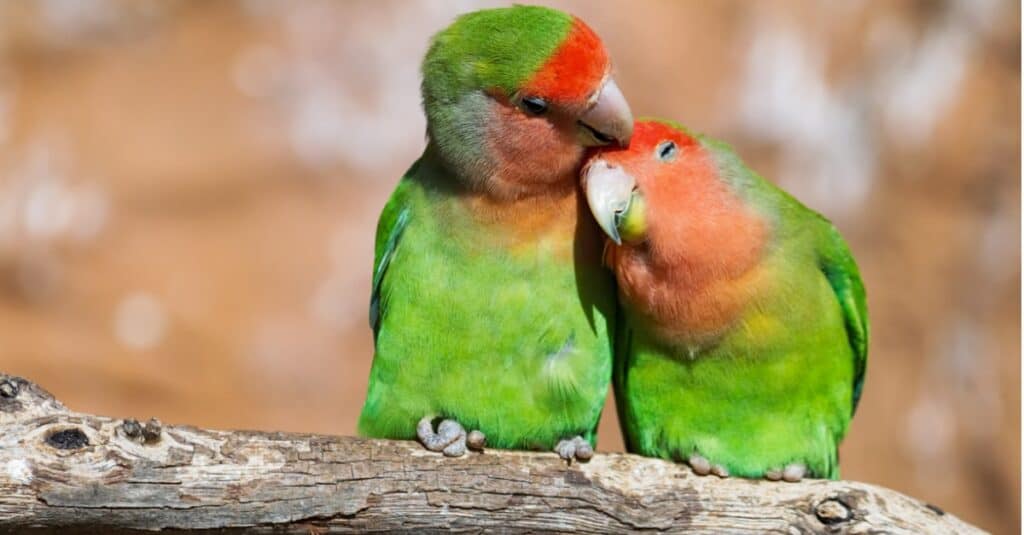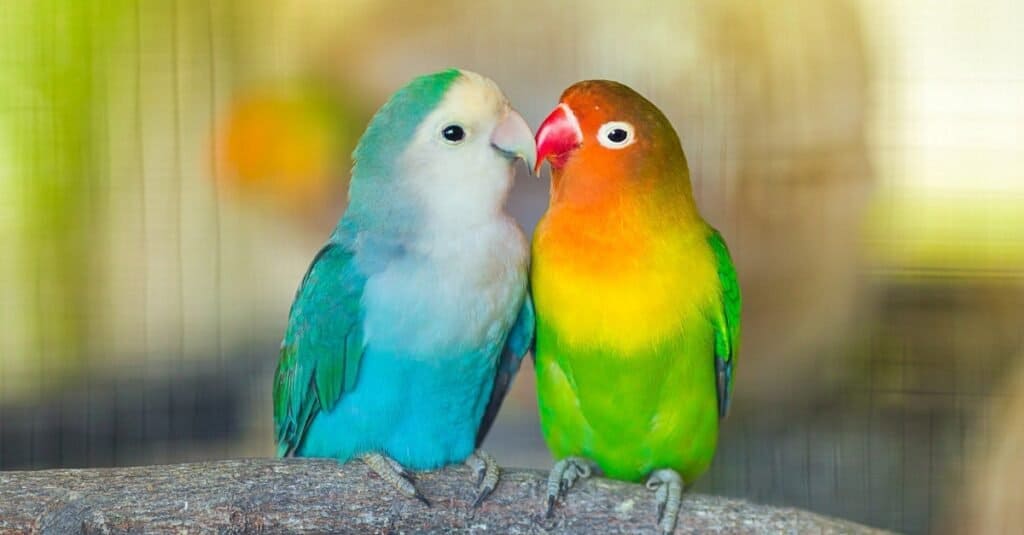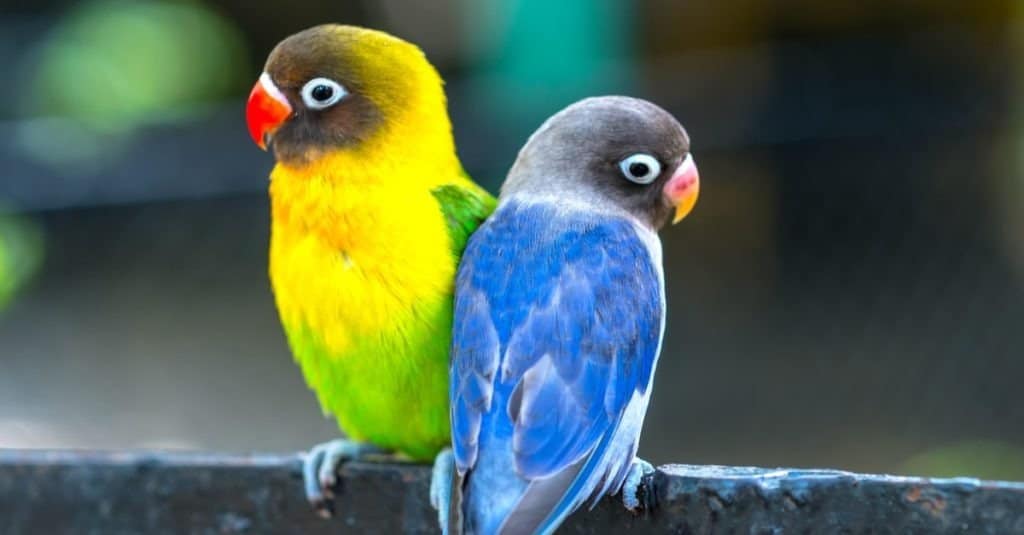Lovebirds are a group of parrots that live on the African continent, with a single species living in Madagascar. These beautiful birds are well-known for their monogamous pairing and have inspired phrases like “a couple of lovebirds,” implying that two people are in love. With how beautiful and social these birds are, it’s no wonder people love to refer to them in their romance and keep them as pets. Let’s look and learn: what do lovebirds eat?
What do lovebirds eat?

Lovebirds are usually herbivores that eat seeds. nuts, fruits, berries, and flower buds.
©irakite/Shutterstock.com
Lovebirds eat seeds, fruits, berries, and leaf buds, with some species eating insects.
Almost all species of lovebirds have similar diets. In the wild, these colorful birds are generally herbivores, but some species are known to include insects in their diets.
There are dozens of food a lovebird could potentially eat in the wild. When it comes to specific types, geography plays an important role, especially since Africa is such a large and varied continent. Most species live in sub-Saharan Africa, primarily in the jungle, where food is plenty. Various species can be found in Tanzania, Zambia, Malawi, Botswana, South Africa, Namibia, and Ethiopia.
The exact type of seeds will depend on the region, but lovebirds often eat between 4-10 types every day. A tablespoon of seeds per day is typical. Additionally, fruits play an important role in lovebirds’ diets. Generally, 20-25% of their diet is fruit-based in the wild and in captivity.
Varied diets within their genus
Black-winged lovebirds are the largest of the genus and live in Southern Eritrea all the way to southwestern Ethiopia. They eat fruits, nuts, and seeds like their counterparts, but they have also learned to incorporate insects and figs into their diet.
Black-collared lovebirds are famously difficult to house in captivity, mainly because of their diet. This specific species is native to equatorial Africa and has become dependent on a specific species of native fig. Their diets must include this fig, making feeding in captivity difficult.
Additionally, some species of lovebirds attack local farms and will eat the crops. In those environments, they are generally viewed as pests and looked down on. Since they flock in groups as large as 30, large portions of crops can be eaten at a time. The most vulnerable times for a farmer are during the sowing, seedling, and ripening stages, at least when it comes to avian attacks. These stages are more vulnerable as the seeds are exposed, almost inviting flocks of birds to come down and feast.
A complete list of foods lovebirds eat

In the wild, lovebirds eat around a tablespoon of seeds a day with fruits to supplement.
©iStock.com/apichon_tee
Here is a complete list of foods that lovebirds eat in the wild and in captivity:
- nuts
- seeds
- fruits
- berries
- vegetables
- pellets
- insects
- specialized figs
- powdered supplements
While the list may seem short, there are hundreds, if not thousands, of potential foods that these parrots can eat in their natural habitats.
Which lovebirds can be kept as pets?
Of the nine total species of lovebird, the most commonly kept pet species are the Fischer’s lovebird, black-masked lovebird, and the peach-faced lovebird. While some of the others are kept domestically, many are either too difficult, rare, or have too many specialized needs (like the Black-collared lovebird mentioned).
The black-winged lovebird, Black-cheeked lovebird, grey-headed lovebird, Nyasa lovebird, red-headed lovebird, and black-collard lovebird are all examples of birds that aren’t kept domestically for various reasons. Still, these uncommon birds can sometimes be seen in aviaries at zoos and wildlife exhibits.
What should I feed a pet lovebird?

In captivity, lovebirds can eat pellets, most fruits, seeds, nuts, and vegetables.
©Huy Thoai/Shutterstock.com
Feeding pet lovebirds a healthy diet is essential for good molts, breeding, and temperament (not to mention a long life). While common belief is that seeds are all a lovebird needs, that’s actually not the case. These birds are known as “seed addicted” and should be introduced to a more wholesome diet.
The easiest way to get your parrot all it needs is through a pelletized diet. Pellets are small nutrient bits that contain dehydrated food, vitamins, and various elements that aid in a healthy diet for your bird. Most pet stores and online dealers sell packages of pellets that are pretty inexpensive; just ensure it’s a quality and researched brand.
Additionally, fruits and veggies should be added to their diets as a treat and nutritious element. Some of the most common fruits that pet owners feed their birds are bananas, citrus, berries, mangoes, kiwis, grapes, plums, pears, and watermelon. Almost all fruits are ok for lovebirds; just ensure that any poisonous seeds are removed (specifically in apples). With vegetables, many roots (potatoes and yams) are ok, as well as tomatoes, peas, and lentils.
Whole grains are great for lovebirds, but bread isn’t. Things like flax, oats, quinoa, and barley are all ok, but anything processed should be avoided. If it’s unhealthy for humans, it’s generally unhealthy for your parrot.
Keeping a water dish is helpful as lovebirds drink up to 5% of their weight in water each day. Additionally, they bathe and clean themselves (sometimes just for fun). A clean cage starts with a clean bird.
What foods are dangerous for pet lovebirds?
Let’s go over some unhealthy and toxic foods that lovebirds shouldn’t eat.
Cheap fatty foods aren’t good for your bird for the same reason they aren’t good for you. Anything too salty or processed can cause long-term problems and is generally unhealthy for your bird, especially caffeinated drinks, sugary foods, and any form of alcohol.
Even in small amounts, toxic foods can harm and kill your bird. These foods include avocado, lime, rhubarb, and navy beans.
On another note, some owners wonder if they need stones or grit for their birds. Birds often swallow stones, placing them in their gizzard to act as a crushing force to break apart nuts and seeds. When it comes to lovebirds, gravel is unnecessary since they don’t eat whole grains and nuts, making extra digestive help unneeded.
The photo featured at the top of this post is © Huy Thoai/Shutterstock.com
Thank you for reading! Have some feedback for us? Contact the AZ Animals editorial team.







